Employee Engagement: Analysis, Strategies, and Proposal Report
VerifiedAdded on 2022/09/27
|17
|5208
|40
Report
AI Summary
This report provides a comprehensive analysis of employee engagement, addressing its core concepts, dimensions, and components. It differentiates employee engagement from related concepts like employee satisfaction and involvement, highlighting the factors that drive it, such as autonomy, impact, meaning, connection, and growth. The report emphasizes the importance of aligning engagement practices with other corporate components, including values, business strategy, purpose, and mission, to foster a positive organizational culture and enhance employee performance. Key drivers of employee engagement, such as involvement in decision-making, the ability to voice ideas, opportunities for job development, and concern for employee well-being, are identified. The report also discusses the impact of job design, discretionary effort, role autonomy, and organizational citizenship on engagement levels. It underscores the benefits of high employee engagement, including increased customer loyalty, employee satisfaction, and profitability, as well as lower turnover and higher employee retention. The report concludes with a call to action for managers and employers to design jobs that maximize engagement and create an environment that encourages discretionary effort and employee empowerment.

Student’s Last Name 1
Employee Engagement
By (Name)
Course
Professor
University
Date
Employee Engagement
By (Name)
Course
Professor
University
Date
Paraphrase This Document
Need a fresh take? Get an instant paraphrase of this document with our AI Paraphraser
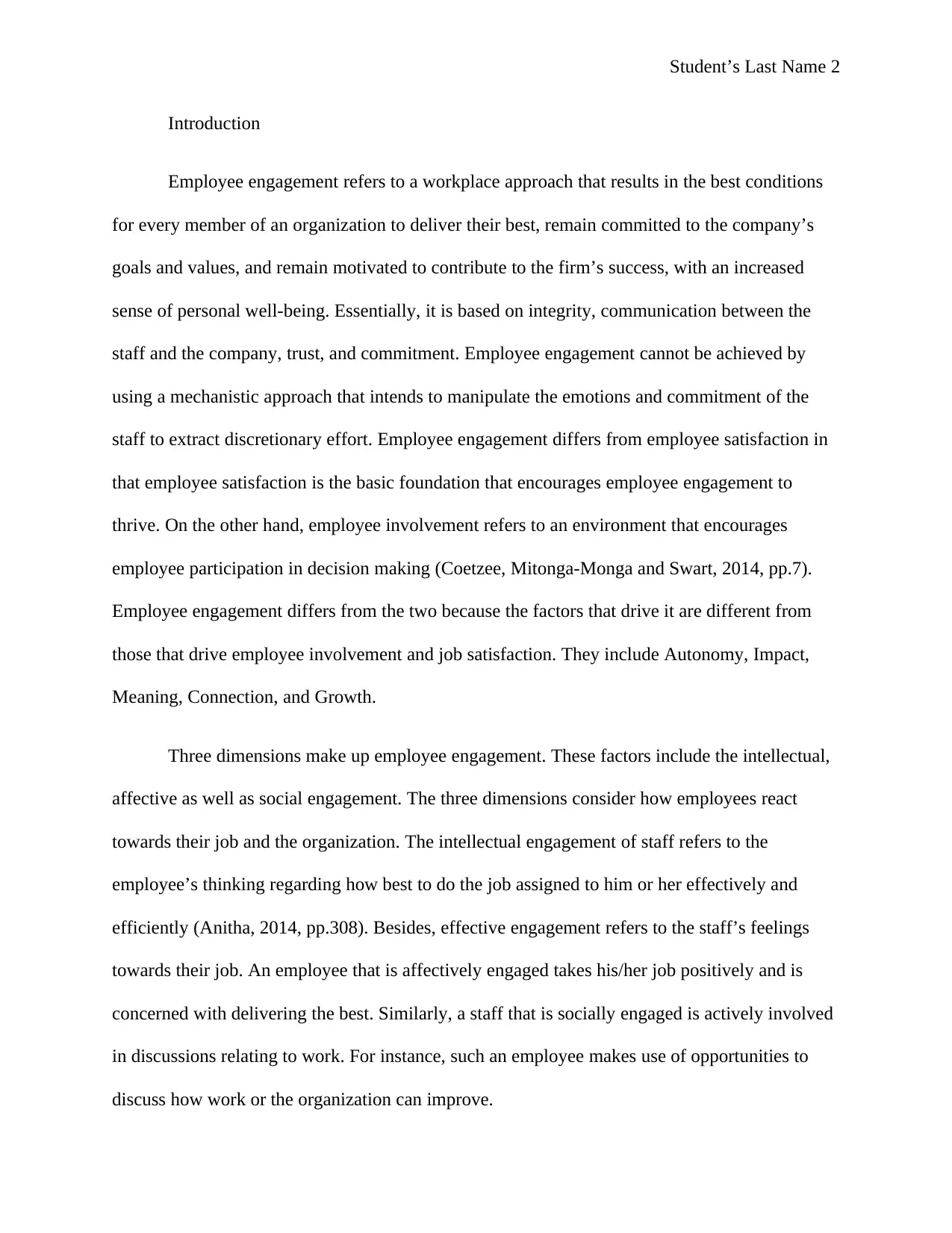
Student’s Last Name 2
Introduction
Employee engagement refers to a workplace approach that results in the best conditions
for every member of an organization to deliver their best, remain committed to the company’s
goals and values, and remain motivated to contribute to the firm’s success, with an increased
sense of personal well-being. Essentially, it is based on integrity, communication between the
staff and the company, trust, and commitment. Employee engagement cannot be achieved by
using a mechanistic approach that intends to manipulate the emotions and commitment of the
staff to extract discretionary effort. Employee engagement differs from employee satisfaction in
that employee satisfaction is the basic foundation that encourages employee engagement to
thrive. On the other hand, employee involvement refers to an environment that encourages
employee participation in decision making (Coetzee, Mitonga-Monga and Swart, 2014, pp.7).
Employee engagement differs from the two because the factors that drive it are different from
those that drive employee involvement and job satisfaction. They include Autonomy, Impact,
Meaning, Connection, and Growth.
Three dimensions make up employee engagement. These factors include the intellectual,
affective as well as social engagement. The three dimensions consider how employees react
towards their job and the organization. The intellectual engagement of staff refers to the
employee’s thinking regarding how best to do the job assigned to him or her effectively and
efficiently (Anitha, 2014, pp.308). Besides, effective engagement refers to the staff’s feelings
towards their job. An employee that is affectively engaged takes his/her job positively and is
concerned with delivering the best. Similarly, a staff that is socially engaged is actively involved
in discussions relating to work. For instance, such an employee makes use of opportunities to
discuss how work or the organization can improve.
Introduction
Employee engagement refers to a workplace approach that results in the best conditions
for every member of an organization to deliver their best, remain committed to the company’s
goals and values, and remain motivated to contribute to the firm’s success, with an increased
sense of personal well-being. Essentially, it is based on integrity, communication between the
staff and the company, trust, and commitment. Employee engagement cannot be achieved by
using a mechanistic approach that intends to manipulate the emotions and commitment of the
staff to extract discretionary effort. Employee engagement differs from employee satisfaction in
that employee satisfaction is the basic foundation that encourages employee engagement to
thrive. On the other hand, employee involvement refers to an environment that encourages
employee participation in decision making (Coetzee, Mitonga-Monga and Swart, 2014, pp.7).
Employee engagement differs from the two because the factors that drive it are different from
those that drive employee involvement and job satisfaction. They include Autonomy, Impact,
Meaning, Connection, and Growth.
Three dimensions make up employee engagement. These factors include the intellectual,
affective as well as social engagement. The three dimensions consider how employees react
towards their job and the organization. The intellectual engagement of staff refers to the
employee’s thinking regarding how best to do the job assigned to him or her effectively and
efficiently (Anitha, 2014, pp.308). Besides, effective engagement refers to the staff’s feelings
towards their job. An employee that is affectively engaged takes his/her job positively and is
concerned with delivering the best. Similarly, a staff that is socially engaged is actively involved
in discussions relating to work. For instance, such an employee makes use of opportunities to
discuss how work or the organization can improve.
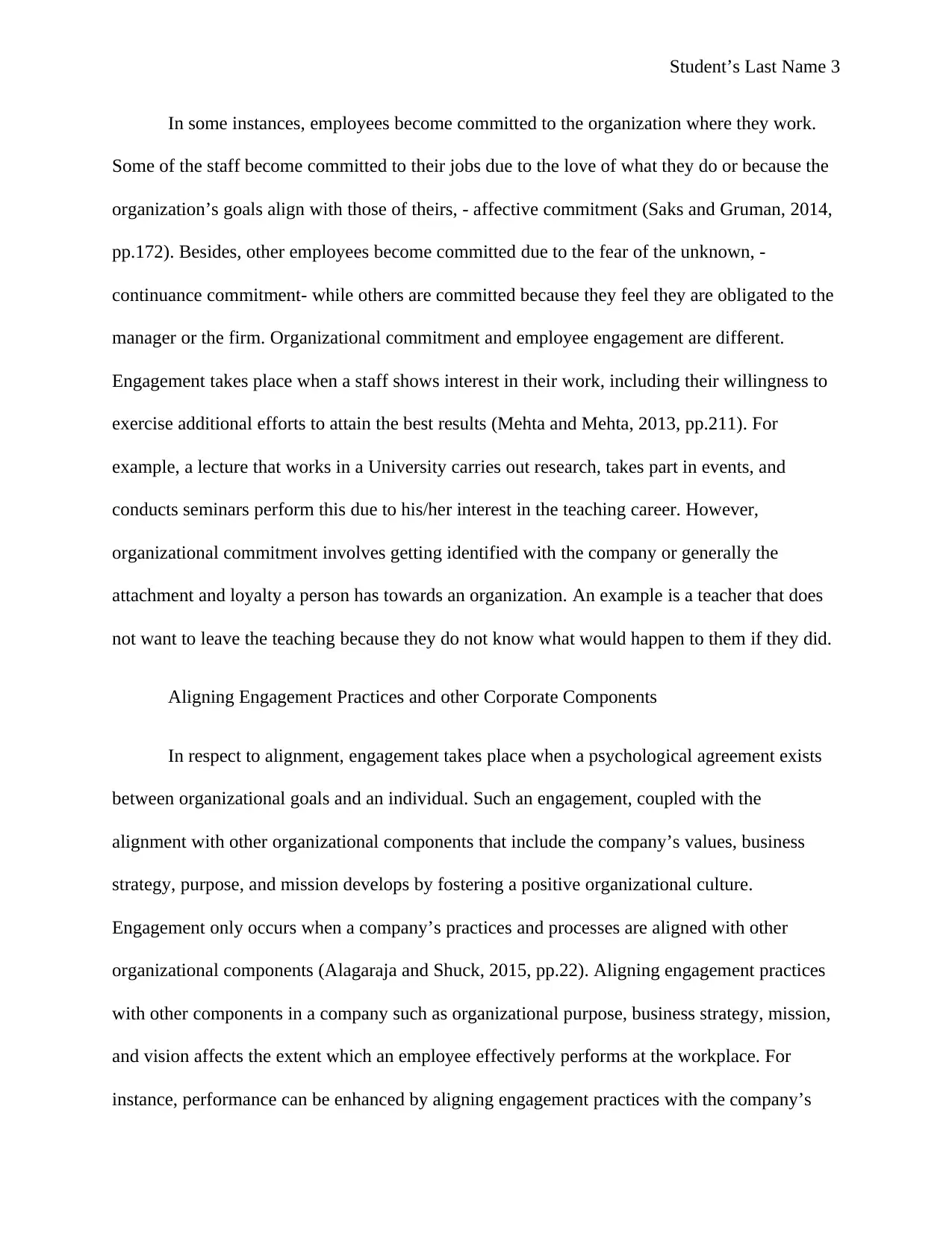
Student’s Last Name 3
In some instances, employees become committed to the organization where they work.
Some of the staff become committed to their jobs due to the love of what they do or because the
organization’s goals align with those of theirs, - affective commitment (Saks and Gruman, 2014,
pp.172). Besides, other employees become committed due to the fear of the unknown, -
continuance commitment- while others are committed because they feel they are obligated to the
manager or the firm. Organizational commitment and employee engagement are different.
Engagement takes place when a staff shows interest in their work, including their willingness to
exercise additional efforts to attain the best results (Mehta and Mehta, 2013, pp.211). For
example, a lecture that works in a University carries out research, takes part in events, and
conducts seminars perform this due to his/her interest in the teaching career. However,
organizational commitment involves getting identified with the company or generally the
attachment and loyalty a person has towards an organization. An example is a teacher that does
not want to leave the teaching because they do not know what would happen to them if they did.
Aligning Engagement Practices and other Corporate Components
In respect to alignment, engagement takes place when a psychological agreement exists
between organizational goals and an individual. Such an engagement, coupled with the
alignment with other organizational components that include the company’s values, business
strategy, purpose, and mission develops by fostering a positive organizational culture.
Engagement only occurs when a company’s practices and processes are aligned with other
organizational components (Alagaraja and Shuck, 2015, pp.22). Aligning engagement practices
with other components in a company such as organizational purpose, business strategy, mission,
and vision affects the extent which an employee effectively performs at the workplace. For
instance, performance can be enhanced by aligning engagement practices with the company’s
In some instances, employees become committed to the organization where they work.
Some of the staff become committed to their jobs due to the love of what they do or because the
organization’s goals align with those of theirs, - affective commitment (Saks and Gruman, 2014,
pp.172). Besides, other employees become committed due to the fear of the unknown, -
continuance commitment- while others are committed because they feel they are obligated to the
manager or the firm. Organizational commitment and employee engagement are different.
Engagement takes place when a staff shows interest in their work, including their willingness to
exercise additional efforts to attain the best results (Mehta and Mehta, 2013, pp.211). For
example, a lecture that works in a University carries out research, takes part in events, and
conducts seminars perform this due to his/her interest in the teaching career. However,
organizational commitment involves getting identified with the company or generally the
attachment and loyalty a person has towards an organization. An example is a teacher that does
not want to leave the teaching because they do not know what would happen to them if they did.
Aligning Engagement Practices and other Corporate Components
In respect to alignment, engagement takes place when a psychological agreement exists
between organizational goals and an individual. Such an engagement, coupled with the
alignment with other organizational components that include the company’s values, business
strategy, purpose, and mission develops by fostering a positive organizational culture.
Engagement only occurs when a company’s practices and processes are aligned with other
organizational components (Alagaraja and Shuck, 2015, pp.22). Aligning engagement practices
with other components in a company such as organizational purpose, business strategy, mission,
and vision affects the extent which an employee effectively performs at the workplace. For
instance, performance can be enhanced by aligning engagement practices with the company’s
⊘ This is a preview!⊘
Do you want full access?
Subscribe today to unlock all pages.

Trusted by 1+ million students worldwide

Student’s Last Name 4
strategic planning, strategy-structure, and strategy-culture. Combined, these processes are
referred to as organizational processes, routines, as well as procedures that affect how an
employee perceives and respond to their job and the organization (Biggs, Brough and Barbour,
2014, pp.312). As a result, effective alignment of these components impacts the employee’s
cognitive as well as psychological appraisal and the interpretation of their work environment. Is
the interpretation and appraisal are positive, this has the potential of producing behaviors that
support the firm. However, failure to align engagement practices with other organizational
components is likely to translate to ineffective performance.
Factors that describe the job and reflect what comprises a workplace are the strategic
goals, values, mission, vision, and purpose. In case there is a misalignment between engagement
practices and these components, there is likely to be miscues in performance. On the contrary, if
the staff understands the company’s mission and vision, goals, strategy, and purpose, they can
develop the meaning of their duties, skills, and knowledge, thus spurring engagement. The
outcome for this is a high performance which can be translated to the company’s revenues. Also,
aligning engagement practices with other organizational components may yield a great deal for a
company (Allen, 2012, n.d.). High engagement benefits can be realized as the staff is willing to
go the extra mile to ensure the goals, mission, and vision are achieved by adopting the
company’s strategy. Due to such alignment, the staff become more committed to the
organization’s future and are ready to invest in the firm due to the belief that they possess the
ability to make a difference. As a result, they become the organization’s ambassadors, hence,
having a positive impact on their output. According to a study carried by Gallup, - a data analysis
and management consultancy- there is a strong interrelationship between aligning engagement
strategic planning, strategy-structure, and strategy-culture. Combined, these processes are
referred to as organizational processes, routines, as well as procedures that affect how an
employee perceives and respond to their job and the organization (Biggs, Brough and Barbour,
2014, pp.312). As a result, effective alignment of these components impacts the employee’s
cognitive as well as psychological appraisal and the interpretation of their work environment. Is
the interpretation and appraisal are positive, this has the potential of producing behaviors that
support the firm. However, failure to align engagement practices with other organizational
components is likely to translate to ineffective performance.
Factors that describe the job and reflect what comprises a workplace are the strategic
goals, values, mission, vision, and purpose. In case there is a misalignment between engagement
practices and these components, there is likely to be miscues in performance. On the contrary, if
the staff understands the company’s mission and vision, goals, strategy, and purpose, they can
develop the meaning of their duties, skills, and knowledge, thus spurring engagement. The
outcome for this is a high performance which can be translated to the company’s revenues. Also,
aligning engagement practices with other organizational components may yield a great deal for a
company (Allen, 2012, n.d.). High engagement benefits can be realized as the staff is willing to
go the extra mile to ensure the goals, mission, and vision are achieved by adopting the
company’s strategy. Due to such alignment, the staff become more committed to the
organization’s future and are ready to invest in the firm due to the belief that they possess the
ability to make a difference. As a result, they become the organization’s ambassadors, hence,
having a positive impact on their output. According to a study carried by Gallup, - a data analysis
and management consultancy- there is a strong interrelationship between aligning engagement
Paraphrase This Document
Need a fresh take? Get an instant paraphrase of this document with our AI Paraphraser
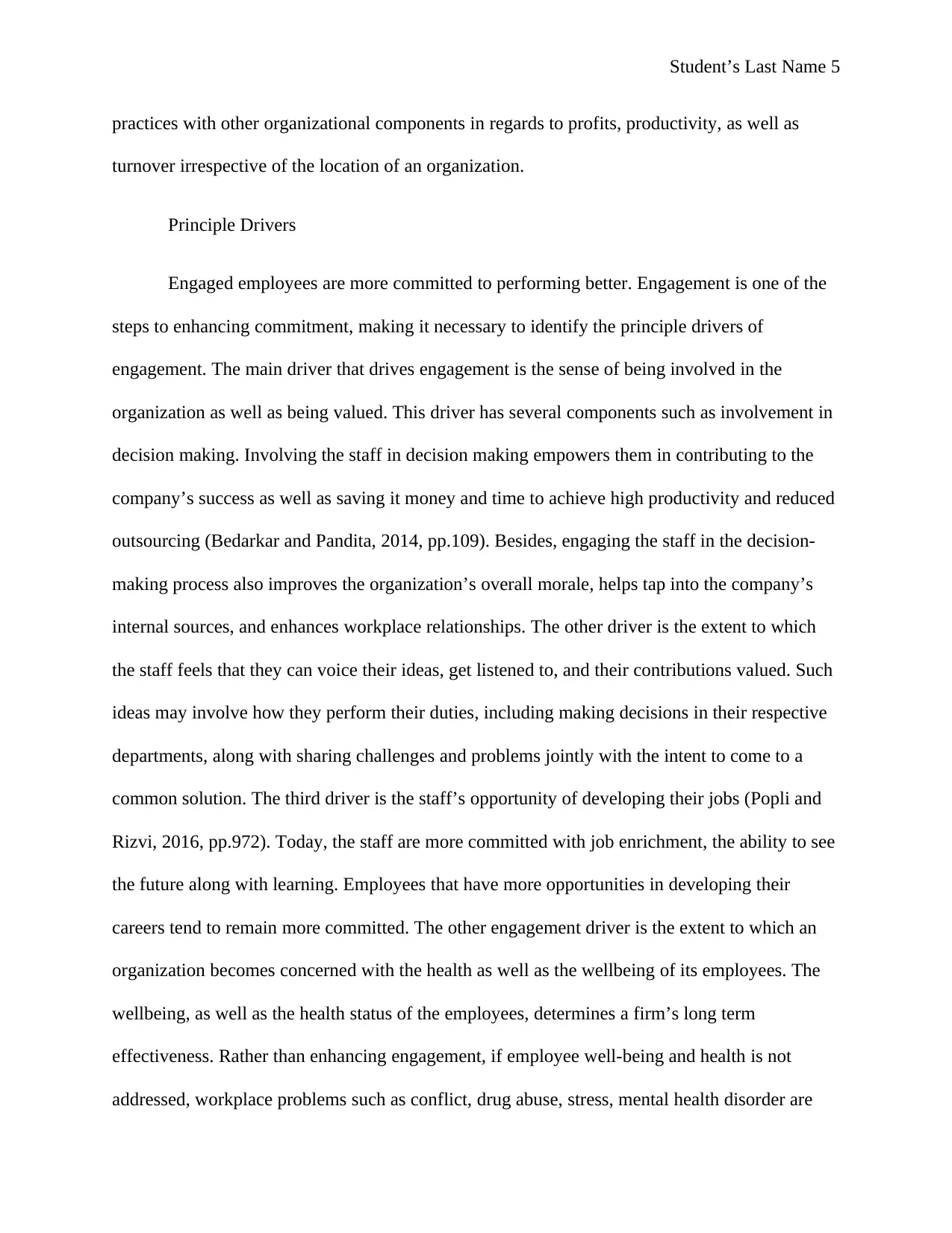
Student’s Last Name 5
practices with other organizational components in regards to profits, productivity, as well as
turnover irrespective of the location of an organization.
Principle Drivers
Engaged employees are more committed to performing better. Engagement is one of the
steps to enhancing commitment, making it necessary to identify the principle drivers of
engagement. The main driver that drives engagement is the sense of being involved in the
organization as well as being valued. This driver has several components such as involvement in
decision making. Involving the staff in decision making empowers them in contributing to the
company’s success as well as saving it money and time to achieve high productivity and reduced
outsourcing (Bedarkar and Pandita, 2014, pp.109). Besides, engaging the staff in the decision-
making process also improves the organization’s overall morale, helps tap into the company’s
internal sources, and enhances workplace relationships. The other driver is the extent to which
the staff feels that they can voice their ideas, get listened to, and their contributions valued. Such
ideas may involve how they perform their duties, including making decisions in their respective
departments, along with sharing challenges and problems jointly with the intent to come to a
common solution. The third driver is the staff’s opportunity of developing their jobs (Popli and
Rizvi, 2016, pp.972). Today, the staff are more committed with job enrichment, the ability to see
the future along with learning. Employees that have more opportunities in developing their
careers tend to remain more committed. The other engagement driver is the extent to which an
organization becomes concerned with the health as well as the wellbeing of its employees. The
wellbeing, as well as the health status of the employees, determines a firm’s long term
effectiveness. Rather than enhancing engagement, if employee well-being and health is not
addressed, workplace problems such as conflict, drug abuse, stress, mental health disorder are
practices with other organizational components in regards to profits, productivity, as well as
turnover irrespective of the location of an organization.
Principle Drivers
Engaged employees are more committed to performing better. Engagement is one of the
steps to enhancing commitment, making it necessary to identify the principle drivers of
engagement. The main driver that drives engagement is the sense of being involved in the
organization as well as being valued. This driver has several components such as involvement in
decision making. Involving the staff in decision making empowers them in contributing to the
company’s success as well as saving it money and time to achieve high productivity and reduced
outsourcing (Bedarkar and Pandita, 2014, pp.109). Besides, engaging the staff in the decision-
making process also improves the organization’s overall morale, helps tap into the company’s
internal sources, and enhances workplace relationships. The other driver is the extent to which
the staff feels that they can voice their ideas, get listened to, and their contributions valued. Such
ideas may involve how they perform their duties, including making decisions in their respective
departments, along with sharing challenges and problems jointly with the intent to come to a
common solution. The third driver is the staff’s opportunity of developing their jobs (Popli and
Rizvi, 2016, pp.972). Today, the staff are more committed with job enrichment, the ability to see
the future along with learning. Employees that have more opportunities in developing their
careers tend to remain more committed. The other engagement driver is the extent to which an
organization becomes concerned with the health as well as the wellbeing of its employees. The
wellbeing, as well as the health status of the employees, determines a firm’s long term
effectiveness. Rather than enhancing engagement, if employee well-being and health is not
addressed, workplace problems such as conflict, drug abuse, stress, mental health disorder are

Student’s Last Name 6
likely to arise. However, if these perspectives are considered by management, productivity tends
to increase among the staff.
In today’s workforce, employee engagement has become a focal point in organizations
due to the realization that to ensure that the customers are happy and satisfied, the firm should
ensure that the staff are happy and committed. Increased customer loyalty results from high
levels of employee engagement. As a result, compared to organizations possessing lackluster
engagement levels, this translates to an increased number of repeated purchases as well as
enhanced word-of-mouth marketing. Once engaged, employees act as brand ambassadors,
preaching the benefits of the company’s products. Nonetheless, they are passionate about dealing
with the clients, making every customer interaction memorable since they are concerned with the
company’s wellbeing (Armstrong and Taylor, 2017, n.d.). For example, a study conducted by
Hay Group reveals that engaged employees translate to increased revenues and better customer
experience, which results in enhanced customer loyalty. Customer engagement translates to
increased customer loyalty because the staff provides better customer service, they offer a better
brand experience and makes the company more customer-focused.
Nonetheless, employee engagement also leads to high employee satisfaction. When not
satisfied with their duties, employees become less concerned about their roles and organizational
growth. However, when they are engaged and feel satisfied with what they do, the staff becomes
more connected to the firm. As a result, they are more capable of producing quality work, which
is of benefit both to the customer and the company at large (Bibb, 2016, n.d.). For example, an
engaged nurse is more willing and ready to go the extra mile in making sure that he or she
delivers her services to the patients. Besides, because they love what they do, engaged staff work
harder, faster, and stronger. Also, high levels of engagement are beneficial to the manager
likely to arise. However, if these perspectives are considered by management, productivity tends
to increase among the staff.
In today’s workforce, employee engagement has become a focal point in organizations
due to the realization that to ensure that the customers are happy and satisfied, the firm should
ensure that the staff are happy and committed. Increased customer loyalty results from high
levels of employee engagement. As a result, compared to organizations possessing lackluster
engagement levels, this translates to an increased number of repeated purchases as well as
enhanced word-of-mouth marketing. Once engaged, employees act as brand ambassadors,
preaching the benefits of the company’s products. Nonetheless, they are passionate about dealing
with the clients, making every customer interaction memorable since they are concerned with the
company’s wellbeing (Armstrong and Taylor, 2017, n.d.). For example, a study conducted by
Hay Group reveals that engaged employees translate to increased revenues and better customer
experience, which results in enhanced customer loyalty. Customer engagement translates to
increased customer loyalty because the staff provides better customer service, they offer a better
brand experience and makes the company more customer-focused.
Nonetheless, employee engagement also leads to high employee satisfaction. When not
satisfied with their duties, employees become less concerned about their roles and organizational
growth. However, when they are engaged and feel satisfied with what they do, the staff becomes
more connected to the firm. As a result, they are more capable of producing quality work, which
is of benefit both to the customer and the company at large (Bibb, 2016, n.d.). For example, an
engaged nurse is more willing and ready to go the extra mile in making sure that he or she
delivers her services to the patients. Besides, because they love what they do, engaged staff work
harder, faster, and stronger. Also, high levels of engagement are beneficial to the manager
⊘ This is a preview!⊘
Do you want full access?
Subscribe today to unlock all pages.

Trusted by 1+ million students worldwide
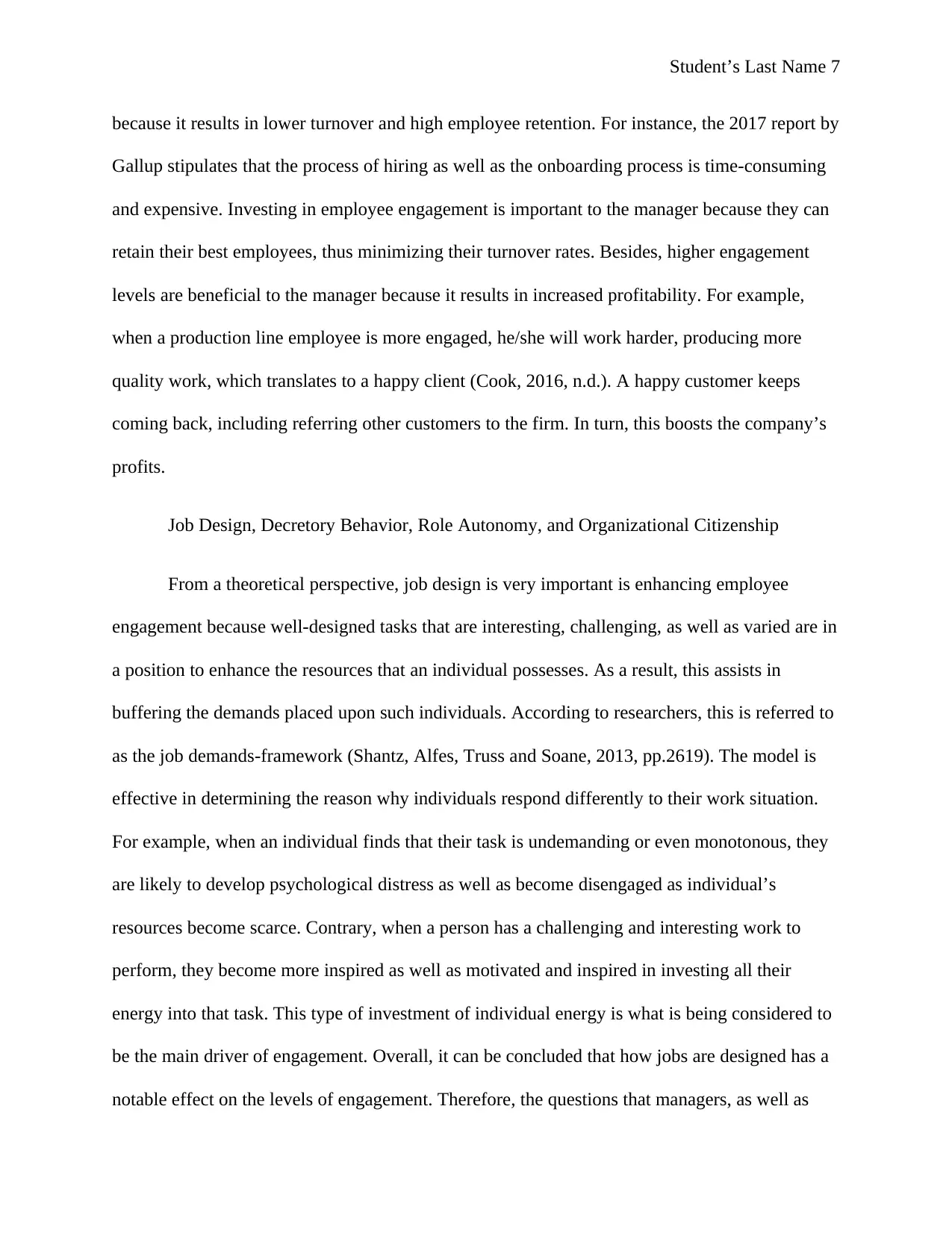
Student’s Last Name 7
because it results in lower turnover and high employee retention. For instance, the 2017 report by
Gallup stipulates that the process of hiring as well as the onboarding process is time-consuming
and expensive. Investing in employee engagement is important to the manager because they can
retain their best employees, thus minimizing their turnover rates. Besides, higher engagement
levels are beneficial to the manager because it results in increased profitability. For example,
when a production line employee is more engaged, he/she will work harder, producing more
quality work, which translates to a happy client (Cook, 2016, n.d.). A happy customer keeps
coming back, including referring other customers to the firm. In turn, this boosts the company’s
profits.
Job Design, Decretory Behavior, Role Autonomy, and Organizational Citizenship
From a theoretical perspective, job design is very important is enhancing employee
engagement because well-designed tasks that are interesting, challenging, as well as varied are in
a position to enhance the resources that an individual possesses. As a result, this assists in
buffering the demands placed upon such individuals. According to researchers, this is referred to
as the job demands-framework (Shantz, Alfes, Truss and Soane, 2013, pp.2619). The model is
effective in determining the reason why individuals respond differently to their work situation.
For example, when an individual finds that their task is undemanding or even monotonous, they
are likely to develop psychological distress as well as become disengaged as individual’s
resources become scarce. Contrary, when a person has a challenging and interesting work to
perform, they become more inspired as well as motivated and inspired in investing all their
energy into that task. This type of investment of individual energy is what is being considered to
be the main driver of engagement. Overall, it can be concluded that how jobs are designed has a
notable effect on the levels of engagement. Therefore, the questions that managers, as well as
because it results in lower turnover and high employee retention. For instance, the 2017 report by
Gallup stipulates that the process of hiring as well as the onboarding process is time-consuming
and expensive. Investing in employee engagement is important to the manager because they can
retain their best employees, thus minimizing their turnover rates. Besides, higher engagement
levels are beneficial to the manager because it results in increased profitability. For example,
when a production line employee is more engaged, he/she will work harder, producing more
quality work, which translates to a happy client (Cook, 2016, n.d.). A happy customer keeps
coming back, including referring other customers to the firm. In turn, this boosts the company’s
profits.
Job Design, Decretory Behavior, Role Autonomy, and Organizational Citizenship
From a theoretical perspective, job design is very important is enhancing employee
engagement because well-designed tasks that are interesting, challenging, as well as varied are in
a position to enhance the resources that an individual possesses. As a result, this assists in
buffering the demands placed upon such individuals. According to researchers, this is referred to
as the job demands-framework (Shantz, Alfes, Truss and Soane, 2013, pp.2619). The model is
effective in determining the reason why individuals respond differently to their work situation.
For example, when an individual finds that their task is undemanding or even monotonous, they
are likely to develop psychological distress as well as become disengaged as individual’s
resources become scarce. Contrary, when a person has a challenging and interesting work to
perform, they become more inspired as well as motivated and inspired in investing all their
energy into that task. This type of investment of individual energy is what is being considered to
be the main driver of engagement. Overall, it can be concluded that how jobs are designed has a
notable effect on the levels of engagement. Therefore, the questions that managers, as well as
Paraphrase This Document
Need a fresh take? Get an instant paraphrase of this document with our AI Paraphraser
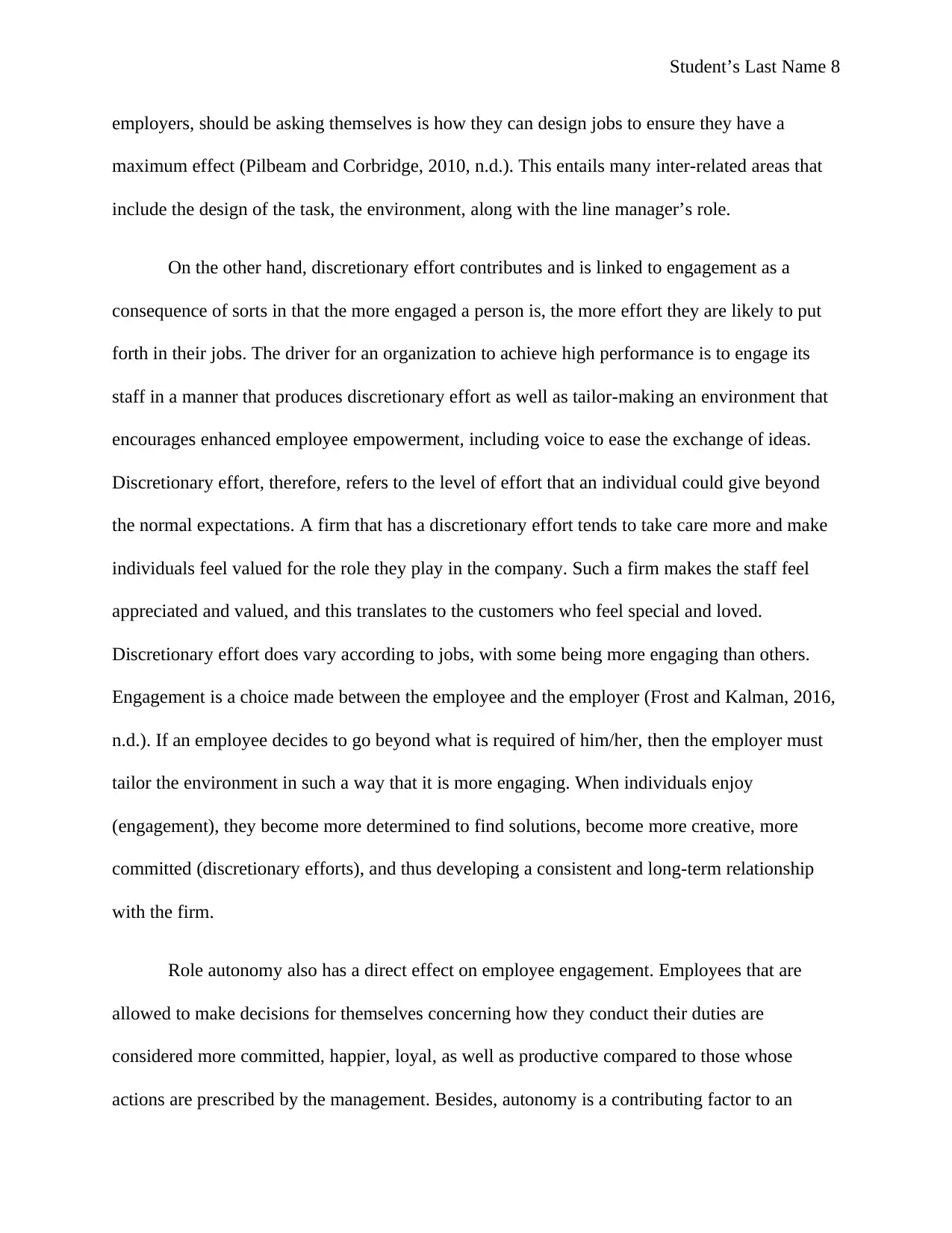
Student’s Last Name 8
employers, should be asking themselves is how they can design jobs to ensure they have a
maximum effect (Pilbeam and Corbridge, 2010, n.d.). This entails many inter-related areas that
include the design of the task, the environment, along with the line manager’s role.
On the other hand, discretionary effort contributes and is linked to engagement as a
consequence of sorts in that the more engaged a person is, the more effort they are likely to put
forth in their jobs. The driver for an organization to achieve high performance is to engage its
staff in a manner that produces discretionary effort as well as tailor-making an environment that
encourages enhanced employee empowerment, including voice to ease the exchange of ideas.
Discretionary effort, therefore, refers to the level of effort that an individual could give beyond
the normal expectations. A firm that has a discretionary effort tends to take care more and make
individuals feel valued for the role they play in the company. Such a firm makes the staff feel
appreciated and valued, and this translates to the customers who feel special and loved.
Discretionary effort does vary according to jobs, with some being more engaging than others.
Engagement is a choice made between the employee and the employer (Frost and Kalman, 2016,
n.d.). If an employee decides to go beyond what is required of him/her, then the employer must
tailor the environment in such a way that it is more engaging. When individuals enjoy
(engagement), they become more determined to find solutions, become more creative, more
committed (discretionary efforts), and thus developing a consistent and long-term relationship
with the firm.
Role autonomy also has a direct effect on employee engagement. Employees that are
allowed to make decisions for themselves concerning how they conduct their duties are
considered more committed, happier, loyal, as well as productive compared to those whose
actions are prescribed by the management. Besides, autonomy is a contributing factor to an
employers, should be asking themselves is how they can design jobs to ensure they have a
maximum effect (Pilbeam and Corbridge, 2010, n.d.). This entails many inter-related areas that
include the design of the task, the environment, along with the line manager’s role.
On the other hand, discretionary effort contributes and is linked to engagement as a
consequence of sorts in that the more engaged a person is, the more effort they are likely to put
forth in their jobs. The driver for an organization to achieve high performance is to engage its
staff in a manner that produces discretionary effort as well as tailor-making an environment that
encourages enhanced employee empowerment, including voice to ease the exchange of ideas.
Discretionary effort, therefore, refers to the level of effort that an individual could give beyond
the normal expectations. A firm that has a discretionary effort tends to take care more and make
individuals feel valued for the role they play in the company. Such a firm makes the staff feel
appreciated and valued, and this translates to the customers who feel special and loved.
Discretionary effort does vary according to jobs, with some being more engaging than others.
Engagement is a choice made between the employee and the employer (Frost and Kalman, 2016,
n.d.). If an employee decides to go beyond what is required of him/her, then the employer must
tailor the environment in such a way that it is more engaging. When individuals enjoy
(engagement), they become more determined to find solutions, become more creative, more
committed (discretionary efforts), and thus developing a consistent and long-term relationship
with the firm.
Role autonomy also has a direct effect on employee engagement. Employees that are
allowed to make decisions for themselves concerning how they conduct their duties are
considered more committed, happier, loyal, as well as productive compared to those whose
actions are prescribed by the management. Besides, autonomy is a contributing factor to an
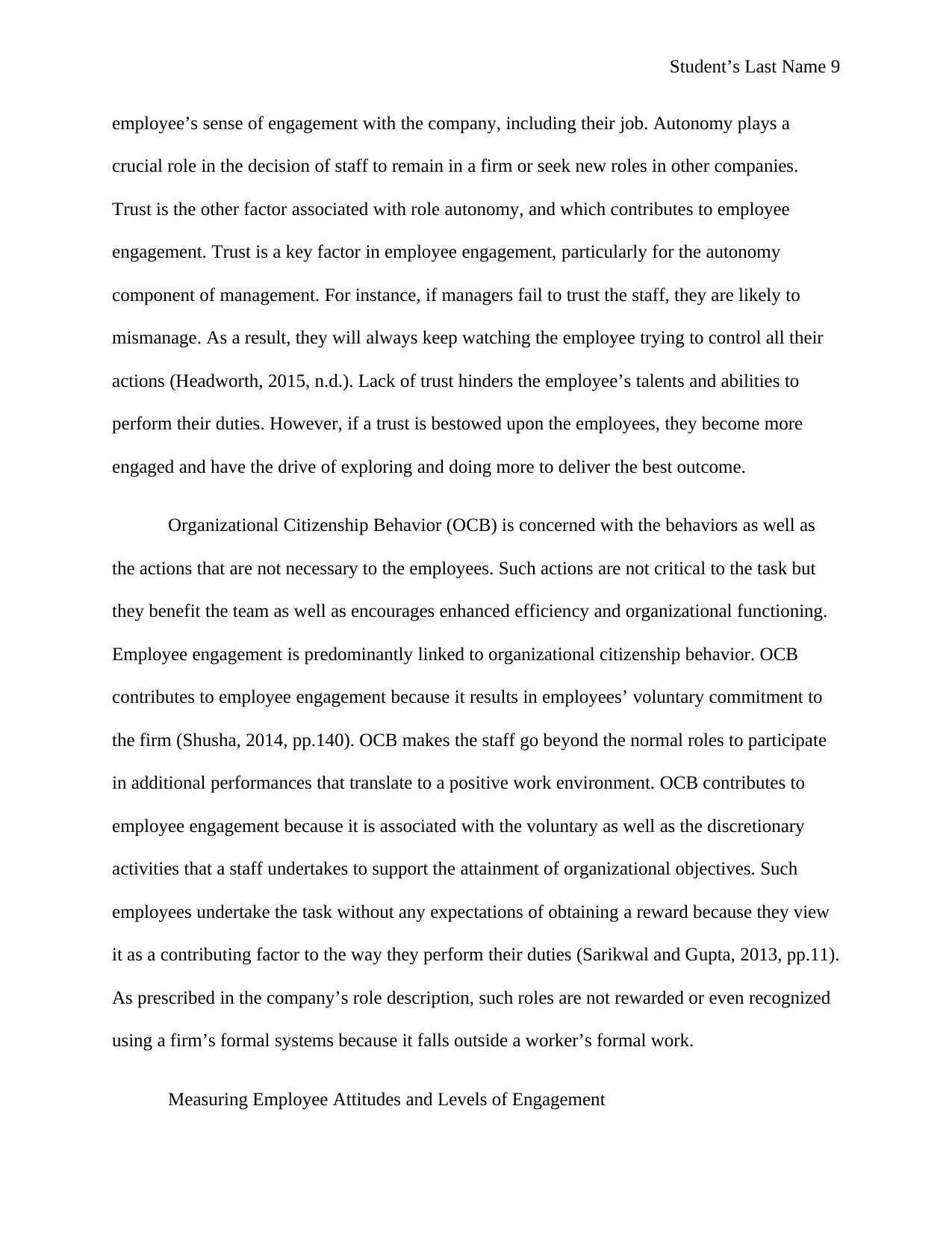
Student’s Last Name 9
employee’s sense of engagement with the company, including their job. Autonomy plays a
crucial role in the decision of staff to remain in a firm or seek new roles in other companies.
Trust is the other factor associated with role autonomy, and which contributes to employee
engagement. Trust is a key factor in employee engagement, particularly for the autonomy
component of management. For instance, if managers fail to trust the staff, they are likely to
mismanage. As a result, they will always keep watching the employee trying to control all their
actions (Headworth, 2015, n.d.). Lack of trust hinders the employee’s talents and abilities to
perform their duties. However, if a trust is bestowed upon the employees, they become more
engaged and have the drive of exploring and doing more to deliver the best outcome.
Organizational Citizenship Behavior (OCB) is concerned with the behaviors as well as
the actions that are not necessary to the employees. Such actions are not critical to the task but
they benefit the team as well as encourages enhanced efficiency and organizational functioning.
Employee engagement is predominantly linked to organizational citizenship behavior. OCB
contributes to employee engagement because it results in employees’ voluntary commitment to
the firm (Shusha, 2014, pp.140). OCB makes the staff go beyond the normal roles to participate
in additional performances that translate to a positive work environment. OCB contributes to
employee engagement because it is associated with the voluntary as well as the discretionary
activities that a staff undertakes to support the attainment of organizational objectives. Such
employees undertake the task without any expectations of obtaining a reward because they view
it as a contributing factor to the way they perform their duties (Sarikwal and Gupta, 2013, pp.11).
As prescribed in the company’s role description, such roles are not rewarded or even recognized
using a firm’s formal systems because it falls outside a worker’s formal work.
Measuring Employee Attitudes and Levels of Engagement
employee’s sense of engagement with the company, including their job. Autonomy plays a
crucial role in the decision of staff to remain in a firm or seek new roles in other companies.
Trust is the other factor associated with role autonomy, and which contributes to employee
engagement. Trust is a key factor in employee engagement, particularly for the autonomy
component of management. For instance, if managers fail to trust the staff, they are likely to
mismanage. As a result, they will always keep watching the employee trying to control all their
actions (Headworth, 2015, n.d.). Lack of trust hinders the employee’s talents and abilities to
perform their duties. However, if a trust is bestowed upon the employees, they become more
engaged and have the drive of exploring and doing more to deliver the best outcome.
Organizational Citizenship Behavior (OCB) is concerned with the behaviors as well as
the actions that are not necessary to the employees. Such actions are not critical to the task but
they benefit the team as well as encourages enhanced efficiency and organizational functioning.
Employee engagement is predominantly linked to organizational citizenship behavior. OCB
contributes to employee engagement because it results in employees’ voluntary commitment to
the firm (Shusha, 2014, pp.140). OCB makes the staff go beyond the normal roles to participate
in additional performances that translate to a positive work environment. OCB contributes to
employee engagement because it is associated with the voluntary as well as the discretionary
activities that a staff undertakes to support the attainment of organizational objectives. Such
employees undertake the task without any expectations of obtaining a reward because they view
it as a contributing factor to the way they perform their duties (Sarikwal and Gupta, 2013, pp.11).
As prescribed in the company’s role description, such roles are not rewarded or even recognized
using a firm’s formal systems because it falls outside a worker’s formal work.
Measuring Employee Attitudes and Levels of Engagement
⊘ This is a preview!⊘
Do you want full access?
Subscribe today to unlock all pages.

Trusted by 1+ million students worldwide

Student’s Last Name 10
Effectively measuring the level of engagement among employees requires taking into
account different parameters of engagement. Among the key indicators that display an
employee’s level of engagement is their performance as well as their intention to stick with the
company. An engaged that is committed to their duties is likely to be more productive compared
to a person with less interest in the work. Such an engaged staff is observed to identify the best
means of doing their jobs (Elorza, Harris, Aritzeta and Balluerka, 2016, pp.127). There are
different diagnostic tools for measuring the level of employee engagement as well as attitude.
Such tools include the use of metrics such as the low turnover rate. When a staff member is
happy about their work, including the company, they are very minimal chances for him/her
searching for a job in other organizations. Such an employee would not be tempted to leave an
organization for another for a small hike in their salary or better perks. In the current competitive
and stressful work environment, peace of mind is very critical for the workers. Hence, they
would love working in a company where they feel contented and secure. Engage workers are
more motivated and have enhanced morale (Furnham and MacRae, 2017, n.d.). In this case, there
would be fewer grievances as well as conflicts in the company. Also, there would be fewer
instances of indiscipline behavior and absenteeism. Besides, workers that are more engaged
suggest cutting-edge strategies as well as ideas that can be used in improving an organization’s
products and services.
Another tool is the use of climate or employee attitude surveys. The tool is effective in
gathering feedback as well as improving workplace communication. For example, APQC’s Open
Standard Research indicates that the climate surveys are similar to the annual census, meaning
that the workers are surveyed once annually. An example of an organization calculating its
workers' engagement index may use several subsets of survey items that include satisfaction,
Effectively measuring the level of engagement among employees requires taking into
account different parameters of engagement. Among the key indicators that display an
employee’s level of engagement is their performance as well as their intention to stick with the
company. An engaged that is committed to their duties is likely to be more productive compared
to a person with less interest in the work. Such an engaged staff is observed to identify the best
means of doing their jobs (Elorza, Harris, Aritzeta and Balluerka, 2016, pp.127). There are
different diagnostic tools for measuring the level of employee engagement as well as attitude.
Such tools include the use of metrics such as the low turnover rate. When a staff member is
happy about their work, including the company, they are very minimal chances for him/her
searching for a job in other organizations. Such an employee would not be tempted to leave an
organization for another for a small hike in their salary or better perks. In the current competitive
and stressful work environment, peace of mind is very critical for the workers. Hence, they
would love working in a company where they feel contented and secure. Engage workers are
more motivated and have enhanced morale (Furnham and MacRae, 2017, n.d.). In this case, there
would be fewer grievances as well as conflicts in the company. Also, there would be fewer
instances of indiscipline behavior and absenteeism. Besides, workers that are more engaged
suggest cutting-edge strategies as well as ideas that can be used in improving an organization’s
products and services.
Another tool is the use of climate or employee attitude surveys. The tool is effective in
gathering feedback as well as improving workplace communication. For example, APQC’s Open
Standard Research indicates that the climate surveys are similar to the annual census, meaning
that the workers are surveyed once annually. An example of an organization calculating its
workers' engagement index may use several subsets of survey items that include satisfaction,
Paraphrase This Document
Need a fresh take? Get an instant paraphrase of this document with our AI Paraphraser
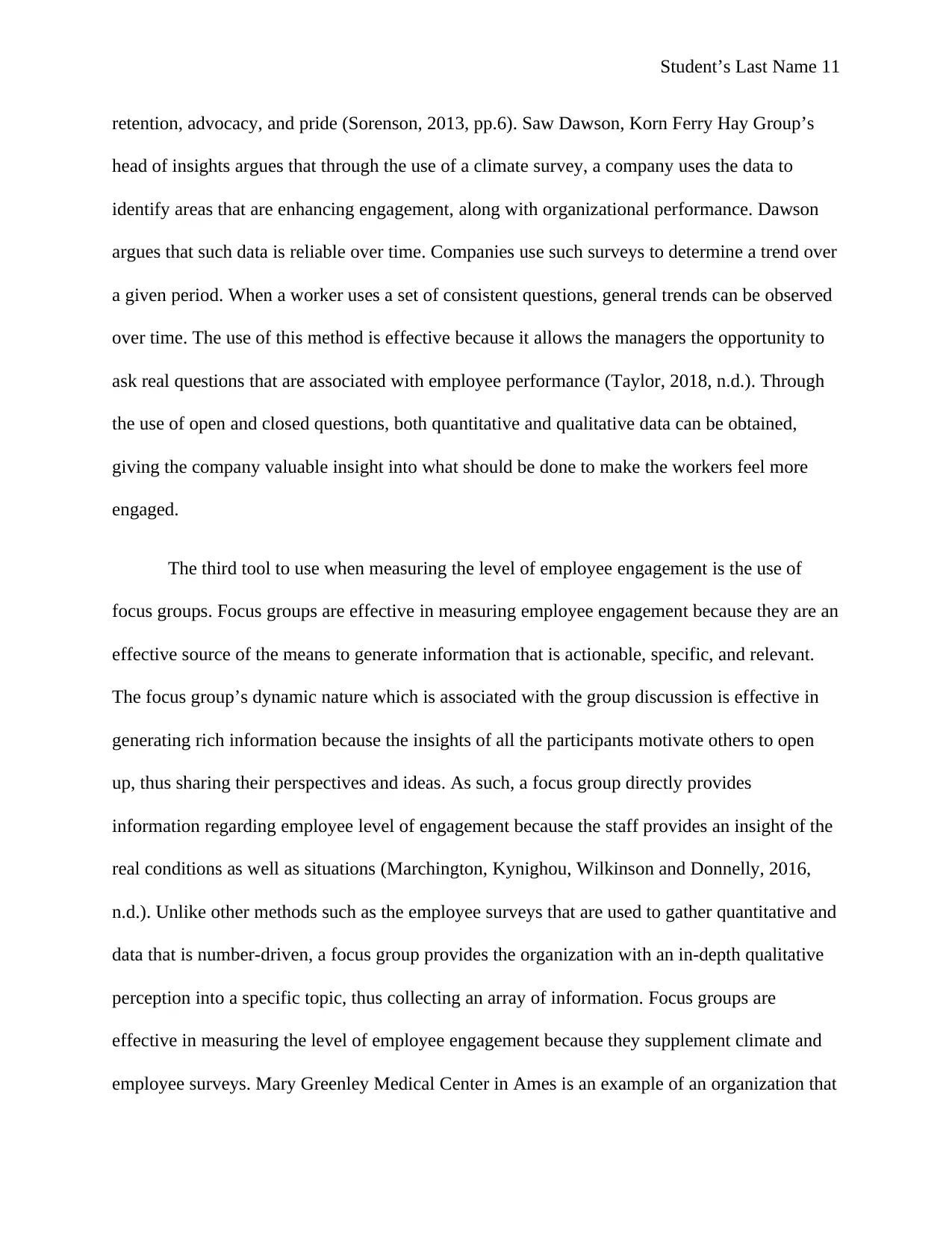
Student’s Last Name 11
retention, advocacy, and pride (Sorenson, 2013, pp.6). Saw Dawson, Korn Ferry Hay Group’s
head of insights argues that through the use of a climate survey, a company uses the data to
identify areas that are enhancing engagement, along with organizational performance. Dawson
argues that such data is reliable over time. Companies use such surveys to determine a trend over
a given period. When a worker uses a set of consistent questions, general trends can be observed
over time. The use of this method is effective because it allows the managers the opportunity to
ask real questions that are associated with employee performance (Taylor, 2018, n.d.). Through
the use of open and closed questions, both quantitative and qualitative data can be obtained,
giving the company valuable insight into what should be done to make the workers feel more
engaged.
The third tool to use when measuring the level of employee engagement is the use of
focus groups. Focus groups are effective in measuring employee engagement because they are an
effective source of the means to generate information that is actionable, specific, and relevant.
The focus group’s dynamic nature which is associated with the group discussion is effective in
generating rich information because the insights of all the participants motivate others to open
up, thus sharing their perspectives and ideas. As such, a focus group directly provides
information regarding employee level of engagement because the staff provides an insight of the
real conditions as well as situations (Marchington, Kynighou, Wilkinson and Donnelly, 2016,
n.d.). Unlike other methods such as the employee surveys that are used to gather quantitative and
data that is number-driven, a focus group provides the organization with an in-depth qualitative
perception into a specific topic, thus collecting an array of information. Focus groups are
effective in measuring the level of employee engagement because they supplement climate and
employee surveys. Mary Greenley Medical Center in Ames is an example of an organization that
retention, advocacy, and pride (Sorenson, 2013, pp.6). Saw Dawson, Korn Ferry Hay Group’s
head of insights argues that through the use of a climate survey, a company uses the data to
identify areas that are enhancing engagement, along with organizational performance. Dawson
argues that such data is reliable over time. Companies use such surveys to determine a trend over
a given period. When a worker uses a set of consistent questions, general trends can be observed
over time. The use of this method is effective because it allows the managers the opportunity to
ask real questions that are associated with employee performance (Taylor, 2018, n.d.). Through
the use of open and closed questions, both quantitative and qualitative data can be obtained,
giving the company valuable insight into what should be done to make the workers feel more
engaged.
The third tool to use when measuring the level of employee engagement is the use of
focus groups. Focus groups are effective in measuring employee engagement because they are an
effective source of the means to generate information that is actionable, specific, and relevant.
The focus group’s dynamic nature which is associated with the group discussion is effective in
generating rich information because the insights of all the participants motivate others to open
up, thus sharing their perspectives and ideas. As such, a focus group directly provides
information regarding employee level of engagement because the staff provides an insight of the
real conditions as well as situations (Marchington, Kynighou, Wilkinson and Donnelly, 2016,
n.d.). Unlike other methods such as the employee surveys that are used to gather quantitative and
data that is number-driven, a focus group provides the organization with an in-depth qualitative
perception into a specific topic, thus collecting an array of information. Focus groups are
effective in measuring the level of employee engagement because they supplement climate and
employee surveys. Mary Greenley Medical Center in Ames is an example of an organization that

Student’s Last Name 12
uses focus groups to measure engagement. The center has furthered the way it implements its
focus groups with the primary objective being diving deeper into the dissatisfiers that are
obtained from the focus groups to develop actionable insights capable of driving improvement.
Employee Value Proposition
An Employee Value Proposition (EVP) refers to the value that is gained by the staff for
working in a company. Such value may consist of financial compensation, benefits, along with
perks that may comprise of assistance in career development or work-life balance. An effective
is crucial for an organization to retain the best talent. Nonetheless, it is also essential for the HR
department in attracting new talent. An EVP involves creating a balance between a reward and
recognition as a result of the performance of the staff. The approach is people-centered because it
focuses on existing workers as well as the integrated manpower plan because it originates from
existing staff (Kwon, Kim and Lee, 2013, pp.297). Thus, an EVP should be compelling, unique,
strategically focused, and original. An EVP is important to the organization for two main
reasons. When an employee value proposition is correctly presented, it can offer a detailed look
into every position, ensuring that the role is attractive to the top talent and allows the candidates
to discover if they will become a good fit. Besides, an effective EVP enhances and elevates an
organization’s employment brand, making the company a landing point that is more desired by
new top candidates (O'Meara and Petzall, 2013, n.d.). Since the organization has a clear vision,
the candidates will become even more attracted to it. Besides the two benefits, a good EVP also
helps build competitive advantage, workers feel more engaged, committed, and motivated hence
resulting in increased productivity.
Describing the EVP
uses focus groups to measure engagement. The center has furthered the way it implements its
focus groups with the primary objective being diving deeper into the dissatisfiers that are
obtained from the focus groups to develop actionable insights capable of driving improvement.
Employee Value Proposition
An Employee Value Proposition (EVP) refers to the value that is gained by the staff for
working in a company. Such value may consist of financial compensation, benefits, along with
perks that may comprise of assistance in career development or work-life balance. An effective
is crucial for an organization to retain the best talent. Nonetheless, it is also essential for the HR
department in attracting new talent. An EVP involves creating a balance between a reward and
recognition as a result of the performance of the staff. The approach is people-centered because it
focuses on existing workers as well as the integrated manpower plan because it originates from
existing staff (Kwon, Kim and Lee, 2013, pp.297). Thus, an EVP should be compelling, unique,
strategically focused, and original. An EVP is important to the organization for two main
reasons. When an employee value proposition is correctly presented, it can offer a detailed look
into every position, ensuring that the role is attractive to the top talent and allows the candidates
to discover if they will become a good fit. Besides, an effective EVP enhances and elevates an
organization’s employment brand, making the company a landing point that is more desired by
new top candidates (O'Meara and Petzall, 2013, n.d.). Since the organization has a clear vision,
the candidates will become even more attracted to it. Besides the two benefits, a good EVP also
helps build competitive advantage, workers feel more engaged, committed, and motivated hence
resulting in increased productivity.
Describing the EVP
⊘ This is a preview!⊘
Do you want full access?
Subscribe today to unlock all pages.

Trusted by 1+ million students worldwide
1 out of 17
Related Documents
Your All-in-One AI-Powered Toolkit for Academic Success.
+13062052269
info@desklib.com
Available 24*7 on WhatsApp / Email
![[object Object]](/_next/static/media/star-bottom.7253800d.svg)
Unlock your academic potential
Copyright © 2020–2025 A2Z Services. All Rights Reserved. Developed and managed by ZUCOL.





